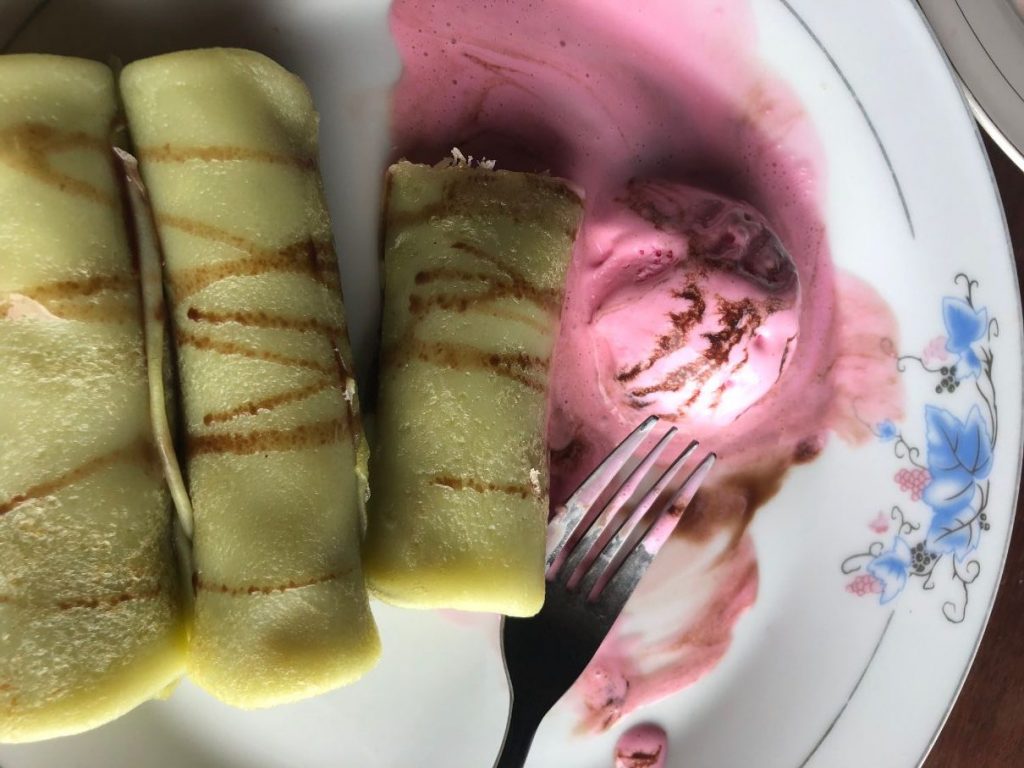Dadar gulung is a traditional Indonesian snack that is made of green pancakes filled with sweet coconut. It is often sold in street markets or served as a dessert.
The word dadar means “omelette” or “pancake” in Indonesian, while gulung means “to roll”. The name describes the shape and appearance of the snack.
The green color of the pancakes comes from pandan leaves, which are also used to give a fragrant aroma and flavor to the batter. Pandan leaves are widely used in Southeast Asian cuisine, and sometimes called the “vanilla of the East”.
The filling of dadar gulung is made of grated coconut, palm sugar, and pandan leaves. Palm sugar is a type of brown sugar that is extracted from the sap of palm trees. It has a caramel-like taste and a sticky texture.
Dadar gulung is believed to originate from Java or Sumatra, and then spread to other parts of Indonesia. It also has variations in Malaysia, Singapore, and Brunei, with slightly different ingredients and methods of preparation.
Dadar gulung is usually eaten as a snack or a dessert, but it can also be served as a breakfast or a side dish. It can be enjoyed hot or cold, and sometimes accompanied by whipped cream, ice cream, or fresh fruits.
Dadar Gulung – Indonesian Pancakes
Dadar was our favourite dish for a quick lunch on Bali. It's a green pancake with coconut filling often served with ice cream on the side. Apparently the recipe is an Indonesian take on European pancakes. The green colour comes from juices of pandanus leaves. I don't think it adds to the taste, it's just a colour.
This recipe is for about 12 pancakes and it should be enough for 4 people. It will have a normal gold-brown colour but you can add a bit of green food coloring if you want to make it look more authentic.
Ingredients
Pancakes
Filling
Instructions
Pancakes
-
Mix milk, eggs and salt in a bowl. Whisk it until smooth
-
Add flour and cornstarch and mix it well
-
Grease a non-stick frying pan and put it on medium heat. Add a small amount of the mixture to the middle of the pan. Turn it around to create an even thin pancake.
-
Flip it over when the bottom part is nicely browned.
-
Continue the same procedure with the rest of the pancake mixture
Filling
-
Put palm sugar and water into a small saucepan and bring it to boil.
-
Change heat to low and continue simmer until thick stirring from time to time. It may take up to 10 minutes.
-
Add coconut and salt. Mix well. Continue cooking on low heat. Stir continuously for few more minutes until mixture is fully absorbed.
-
Remove from heat. Add milk. Mix well and set aside.
Serving Method
-
Put a pancake on a flat surface. In about 3/4 of the pancake add 2 tablespoons of filling. Arrange it into a thin roll but leave edges of the pancake clean.
-
Fold a shorter end of the pancake over the filling. Then fold edges and in the end roll everything up to use the rest of the pancake.
-
Serve Dadar with Icecream of your choice. (optional)
Nutrition Facts
Servings 12
- Amount Per Serving
- Calories 242kcal
- % Daily Value *
- Total Fat 16.1g25%
- Saturated Fat 13.5g68%
- Cholesterol 30mg10%
- Sodium 143mg6%
- Potassium 179mg6%
- Total Carbohydrate 22.8g8%
- Dietary Fiber 2.4g10%
- Sugars 8.9g
- Protein 3.6g8%
* Percent Daily Values are based on a 2,000 calorie diet. Your daily value may be higher or lower depending on your calorie needs.


Leave a Reply